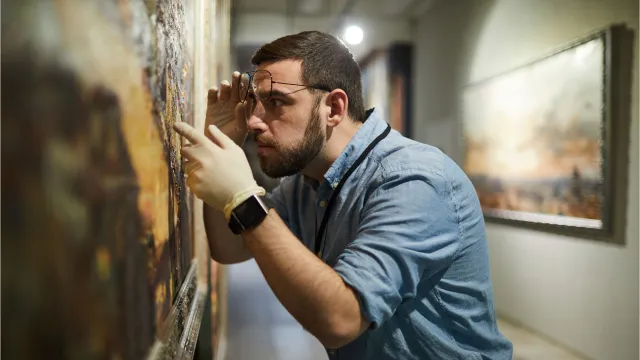Diagnostics on works of art
We provide a service for non-invasive and micro-invasive diagnosis aimed at the study and characterisation of painted surfaces and materials contained in historical and artistic assets such as paintings, frescoes, wood or stone sculptures, archaeological finds and furnishings, guaranteeing the production of reports that take into account the historical and technical aspects of the analytical results, and that are expressed in such a manner as to eliminate difficulties that arise through the use of hyper-scientific language that is often incomprehensible to those who have to use the data gained through analysis and examination. The laboratory uses innovative and avant-garde diagnostic equipment and techniques such as the environmental scanning electron microscope (ESEM), micro-FTiR infra-red spectroscopy and gas chromatography-mass spectrometry. These techniques allow for the carrying out of qualitative and quantitative analysis on semi-microscopic samples either raw or in section.
Furthermore, the use of portable instrumentation allows the majority of examinations to be carried out directly on-site in private locations, museums or restoration workshops, avoiding the need to move the work of art from the place in which it is stored and obtaining immediate answers.
Here is the list of investigations relevant to this type of artifact:
Portable XRF analyses
X-ray fluorescence (XRF) analyses and colorimetric measurements are used to study the chemical composition of the materials in a work or structure, such as pigments, metals, or coatings. These analyses help identify chromatic alterations and variations in material composition caused by aging or environmental factors, enabling restorers to make informed decisions regarding conservation interventions.
Imaging diagnostics
Imaging diagnostics include advanced techniques such as UV, infrared (IR), and reflectographic investigations, which allow the exploration of both surface and underlying layers of artworks. The use of UV light is essential for detecting previous restorations and surface deterioration, while infrared imaging is employed to reveal preparatory drawings and/or pentimenti beneath the paint layers. These techniques provide deeper insight into the methods used by the artist and offer restorers valuable information for conservation planning.
Microstratigraphic analyses
Microstratigraphic analyses allow the characterization of the pictorial materials of polychrome works (preparatory layers, pigments, binders, dyes, varnishes, and altered products).
Scanning Electron Microscope (SEM) analyses
SEM analyses make it possible to identify the nature of the pigments used in paint layers, as well as deposits, crusts, encrustations, restoration products, alteration and degradation compounds, and patinas.
Micro-FTIR analyses
Micro-FTIR analyses performed on each paint layer allow the identification of binders, varnishes, organic materials in general, as well as alteration and degradation products.
